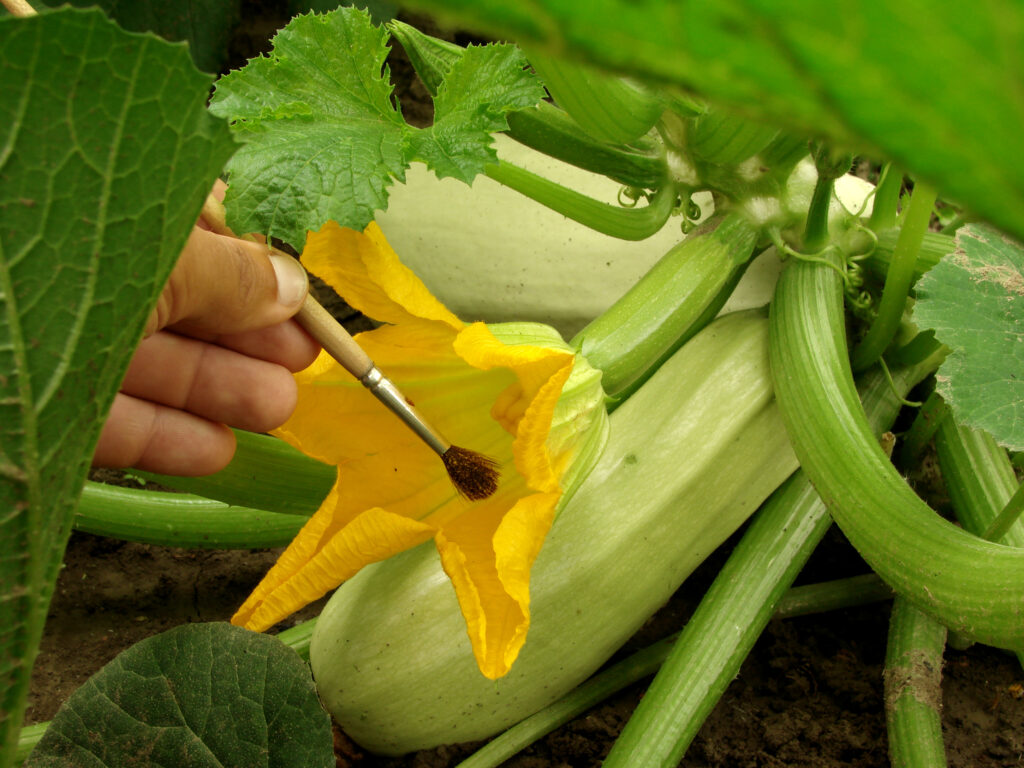One of the most important—but often overlooked—aspects of growing melons is pollination. Without it, your plants will flower beautifully but fail to produce any fruit. After many seasons of growing muskmelons, watermelons, and specialty varieties, I’ve learned that understanding and even assisting the pollination process can dramatically improve yield and fruit quality.
Here’s what every gardener should know about melon pollination, including how and when to hand-pollinate.
How Melon Pollination Works
Melons are monoecious plants, which means they produce separate male and female flowers on the same vine.
🔹 Male Flowers
- Appear first, typically a week or more before any female flowers
- Contain pollen, but no ovary
- Found in clusters, often smaller and on thinner stems
🔹 Female Flowers
- Arrive after male flowers once the plant matures
- Identifiable by a small bulge behind the petals—this is the immature fruit
- Must receive pollen from a male flower for the fruit to develop
🔹 Pollination
Pollination happens when bees or other pollinators transfer pollen from the male flower’s stamen to the female flower’s stigma. Without this, the fruit will not form, or it may start to develop and then wither.
In ideal garden conditions, bees and native pollinators handle this work. But in rainy weather, excessive wind, or areas with few pollinators, you may need to step in.
When to Hand-Pollinate Melons
I always recommend monitoring your melon plants in the early morning when flowers first open. If you’re not seeing bees or other pollinators visiting your garden—or if fruit isn’t forming despite plenty of blossoms—hand-pollination can make the difference between a successful crop and a disappointing one.
Hand-pollination is especially helpful if:
- You’re growing melons in a greenhouse or under row covers
- Pollinator activity is low in your area
- You’re trying to maximize early fruit set for a short growing season

How to Hand-Pollinate Melons
Here’s how I hand-pollinate melons in my garden:
What You’ll Need:
- A soft paintbrush, cotton swab, or simply your fingers
- A freshly opened male flower
- Access to a freshly opened female flower (typically open in early morning)
Step-by-Step:
- Identify the flowers
- Male: No bulge behind petals
- Female: Visible swelling at the base of the flower
- Collect pollen
- Use a paintbrush or swab to gently brush the yellow pollen from the center of a male flower.
- Transfer pollen
- Dab the brush into the center of the female flower, making sure the pollen contacts the sticky stigma.
- Repeat if needed
- One male flower can pollinate multiple female flowers, but I usually do one-to-one for better success.
- Mark pollinated flowers (optional)
- I tie a bit of yarn or garden tape near pollinated flowers so I can track fruit development later.
Tips for Better Pollination Success
- Pollinate early in the day: Flowers are most receptive in the morning.
- Avoid wet flowers: Rain or dew can make pollen clump and reduce effectiveness.
- Encourage bees: Even if you hand-pollinate, planting bee-friendly flowers nearby boosts overall pollination.
- Avoid over-pruning: Flowers often grow at the base of leaf nodes; pruning too much reduces flowering.
Final Thoughts from the Garden
Pollination is the invisible engine behind every melon harvest. Once I understood the difference between male and female flowers—and learned to lend a hand when bees were scarce—I saw a big jump in both the number and size of fruits.
If you’ve ever wondered why your melon vines bloom but don’t bear fruit, the answer almost always lies in pollination. And once you know how to do it yourself, you’re never at the mercy of the weather or bee traffic again.
Melons Overview: The Ultimate Guide to Growing Melons: From Planting to Harvest
Watermelons: How to Grow Watermelons from Seed to Harvest: Ultimate Guide for Sweet, Juicy Success
Related Posts:
Planting & Growing Basics
- When to Plant Melons for the Best Harvest
- Best Soil and Location for Growing Melons
- Planting and Spacing Melons Step-by-Step
- Growing Melons on Mounds and Hills: A Proven Method for Stronger Plants and Sweeter Fruit
Care & Maintenance
- Watering and Feeding Melons for Maximum Sweetness
- Caring for Melons Through the Season: A Practical Guide
- Melon Pollination: How It Works and When to Lend a Hand
- Melon Pests and Diseases: Identification and Control
Space-Saving Techniques
- Melons in Small Spaces: Container Growing Made Easy
- Growing Melons Vertically: Save Space and Boost Harvests
- Trellising Cantaloupes: Why and How
Ripeness & Harvesting
- How to Tell When Melons Are Ripe
- How to Know When Cantaloupes Are Ripe: Slip Stage and Other Signs
- The Gardener’s Guide to Harvesting and Storing Melons for Peak Flavor
Melon Types & Varieties
- Summer Melons vs Winter Melons: Know the Difference
- Growing Gaila, Honeydew, and Crenshaw Melons
- Best Cantaloupe Varieties for Home Gardens
Enjoying the Harvest



